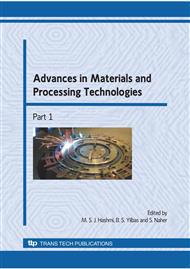p.342
p.350
p.358
p.367
p.375
p.384
p.392
p.400
p.407
Evaluation of the AZ31 Formability According to Temperature Using a Constant Strain Rate Test
Abstract:
The present paper is focused on the Finite Element modeling of the Marciniak stretch-forming test in warm condition. Such a test was proposed by the authors for evaluating the warm formability of the Mg alloy AZ31 according to the most important parameters: the temperature and the strain rate. Tensile tests confirmed the large influence of the strain rate on the deformation of the AZ31, especially when the test temperature is over 200°C. Three dimensional FE simulations were thus carried out in order to analyze the strain and strain rate evolutions during the formability test at the temperature of 200°C. In particular, simulations were aimed at investigating the effect of the specimen’s geometry on the strain rate evolution in the central region, where failure occurs during the Marciniak stretch-forming test. An equation for calculating the punch speed profile able to keep a constant equivalent strain rate in the central region of the specimen has been furnished according to the geometry of the specimen. Its efficiency was validated by means of additional simulations implementing the punch speed profile calculated using the proposed approach.
Info:
Periodical:
Pages:
375-383
Citation:
Online since:
December 2009
Authors:
Price:
Сopyright:
© 2010 Trans Tech Publications Ltd. All Rights Reserved
Share:
Citation:


